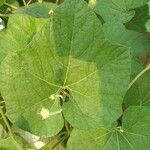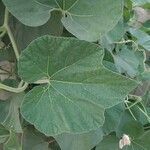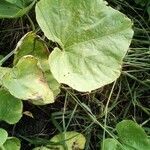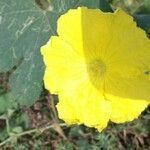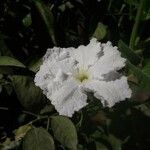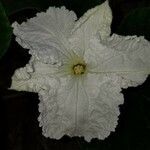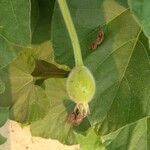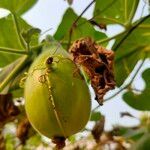Climber or trailer to 4.5 m.; stem herbaceous, rather densely hairy.. Leaves broadly ovate-reniform or suborbicular in outline, cordate, sinuate-toothed, apiculate, hairy beneath and usually also above, 32–230 mm. long, 45–230 mm. broad, undivided or shortly and obscurely palmately 5–9-lobed; lobes rounded; petiole 27–125 mm. long, pubescent, with two small apical lateral conical glands.. Tendrils bifid.. Monoecious.. Male flowers solitary on 75–310 mm. long peduncles; receptacle-tube funnel-shaped, slightly bulbous at the base, pubescent, 11–16 mm. long; lobes linear to triangular, 3–7 mm. long; petals white, opening in the evening, broadly obovate, apiculate, 27–45 mm. long, 18–37 mm. broad; anthers oblong, coherent, included; thecae triplicate, also ± contorted especially in lower part of anther.. Female flowers on ± 60–70 mm. long stalks; ovary ovoid, villous, 11–17 mm. long, 6–8 mm. across; receptacle-tube ± 2.5 mm. long; lobes acute, ± 3–3.5 mm. long; petals ± 30 mm. long and 24 mm. broad.. Fruit large, subglobose, ellipsoid, lageniform, biventricose, clavate or elongated, up to 130 mm. or more in diameter, green, hairy, fleshy, hard-shelled, indehiscent.. Seeds (fig. 6/9, p. 48) oblong, compressed, slightly tapered, slightly 2-horned on the shoulders at the broader end, smooth with 2 flat longitudinal facial ridges fading towards the narrow end and approaching one another medially at the 2-horned end, ± 17 × 7 × 3.2 mm., in some cultivated forms much larger, irregular and ± rugose.
Robust climber or trailer to 5 m long, glabrescent; usually cultivated. Probract absent. Tendrils 2-branched. Leaves: petiole 4-20 cm long, laterally at apex with 2 small (raised) glands; blade unlobed or obscurely 3-9-lobed, reniform, suborbicular or ovate in outline, 5-30 cm diam., cystoliths not obvious, margin (sparsely) finely dentate, soft hairy, apex obtuse or acute. Male flowers: pedicel 40-300 mm long; perianth 40-60(-120) mm diam.; receptacle-tube (long-)campanulate, slightly bulbous at base, 10-15 mm long, soft hairy; sepals spaced, narrowly triangular or linear, c. 5 mm long; petals broadly obovate, 20-40(-50) by (10-)15-35 mm, soft hairy, margin (sub)entire; stamens inserted below halfway in the receptacle-tube, anthers forming a ± elongate whole, filaments free, 2-3 mm long, glabrous; disc gland-like, at base of tube. Female flowers: pedicel 5-7 mm long; ovary cylindrical, reversed flask-shaped or obovoid, 10-20 mm long, villose; receptacle-tube 2-3 mm long; sepals and petals as in male flowers but somewhat smaller. Fruit solitary, ellipsoid or variously flask-shaped, often with a long ‘neck’, (6-)10-80 cm long, up to 20 cm wide, glabrescent; fruiting pedicel 5-10 cm long. Seeds pale brown, subtruncate at both ends, (7-)10-20(-25) mm long, ± 2-horned on the broader end, faces shallowly ornamented and with two submarginal ridges.
Vigorous annual herb. Stems prostrate or scandent, softly villous. Leaf-lamina 3-40 x 4.5-40 cm, broadly ovate or reniform in outline, cordate, shortly and softly puberulous or pubescent, undivided or incipiently palmately 5-7-lobed, the lobes rounded, shallowly sinuate-dentate, apiculate. Petioles 2-30 cm long, densely pubescent or villous; glands small, somewhat recurved, inserted at the base of the lamina. Probracts undeveloped. Flowers monoecious. Male flowers solitary; pedicels 7-31 cm long, softly hairy or villous; receptacle-tube 1.1-1.6 cm long, obconic-cylindrical, villous, lobes remote, 2.5-7 x 1-2 mm, subulate-dentiform or triangular-dentiform. Petals 2-4.5 x 1-3.5 cm, white, obovate. Anthers oblong, included. Female flowers on 6-10 cm long peduncles; ovary 10-25 x 5-8 mm, subglobose to ellipsoid or cylindrical, densely villous; receptacle-lobes and petals similar to those of male flowers. Fruits large, up to 1 m long and 20 cm across, subglobose to cylindrical, often ± biventricose or lageniform, green, becoming yellowish when mature. Seeds 7-20 mm long, oblong, truncate and emarginate at the base, with 2 flat facial ridges, in some variants rather irregular and rugose.
Plants annual. Stem and branches sulcate-angular, pubescent. Tendrils filiform, puberulent. Petiole 16-20 cm, with 2 glands at apex; leaf blade ovate-cordate or reniform-ovate, 10-35 × 10-35 cm, undivided or 3-5-lobed, both surfaces puberulent, palmately 5-7-veined, base cordate, margin irregularly dentate. Plants monoecious; flowers solitary. Male flowers: pedicels slender; calyx tube funnelform, ca. 2 cm; segments lanceolate, ca. 5 mm; corolla yellow; segments 3-4 × 2-3 cm; filaments 3-4 mm; anthers oblong, 8-10 mm. Female flowers: calyx segments and corolla as in male flowers; ovary densely pubescent; stigma enlarged, 2-lobed. Fruit various in size and shape, woody when mature. Seeds white, obovate or triangular, ca. 20 mm, apex truncate. Fl. summer, fr. autumn.
A pumpkin family plant. It is an annual vine with large leaves. It can grow 3-9 m long and spread 3-6 m wide. The thick stems have furrows along them. It can climb over logs by attaching the tendrils which grow out of the stem near the leaf. The leaves are large and have soft hairs especially underneath. Flowers of both sexes are borne in the same plant. The plant produces male flowers first and these are on long stalks. Next it produces female flowers on short stalks. Flowers are large and white. They can be 10 cm across. They are mainly pollinated by insects. Fruit vary in shape. The fruit can be 8-90 cm long. They have brown seeds in a whitish green pulp. There are several varieties.
Stems pilose, to 4 m long. Leaves broadly ovate, sub-triangular or reniform, cordate at base; lamina 4–30 cm long, 5–30 cm wide, sinuate-dentate to shallowly 3–7-lobed, acute, pubescent on both surfaces; petiole 3–20 cm long. Male flowers: pedicels 7–40 cm long; hypanthium 10–35 mm long, pubescent; calyx lobes 5–15 mm long; corolla lobes obovate, apiculate, 20–45 mm long, white. Female flowers: pedicels 6–10 cm long; hypanthium 2–3 mm long; ovary 10–17 mm long, villous. Fruit subglobose, ellipsoidal, ovoid, pyriform or clavate, 10–20 cm diam., green, pubescent. Seeds oblong, truncate, 16–20 mm long, faces ornamented with 2 ridges.
male flowers solitary; pedicels 7–31 cm. long, softly hairy or villous; receptacle-tube 1·1–1·6 cm. long, obconic-cylindrical, villous, lobes remote, 2·5–7 × 1–2 mm., subulate-dentiform or triangular-dentiform. Petals 2–4·5 × 1–3·5 cm., white, obovate. Anthers oblong, included.
Leaf-lamina 3–40 × 4·5–40 cm., broadly ovate or reniform in outline, cordate, shortly and softly puberulous or pubescent, undivided or incipiently palmately 5–7-lobed, the lobes rounded, shallowly sinuate-dentate, apiculate.
Prostrate or scandent annual herb, monoecious (male and female flowers on the same plant). Glands at apex of petiole rather obscure, ± recurved, inserted at base of leaf lamina. Male flowers solitary. Flowers white.
Female flowers on 6–10 cm. long peduncles; ovary 10–25 × 5–8 mm., subglobose to ellipsoid or cylindrical, densely villous; receptacle-lobes and petals similar to those of male flowers.
Fruits large, up to 1 m. long and 20 cm. across, subglobose to cylindrical, often ± biventricose or lageniform, green, becoming yellowish when mature.
Seeds 7–20 mm. long, oblong, truncate and emarginate at the base, with 2 flat facial ridges, in some variants rather irregular and rugose.
Petioles 2–30 cm. long, densely pubescent or villous; glands small, somewhat recurved, inserted at the base of the lamina.
Stems prostrate or scandent, softly villous.
Probracts undeveloped.
Flowers monoecious.
Vigorous annual.
